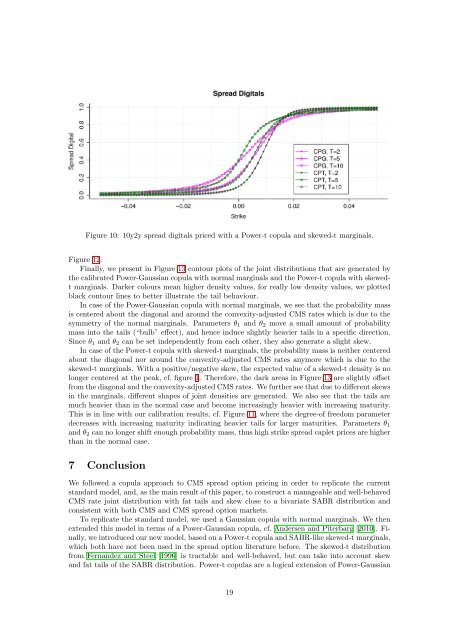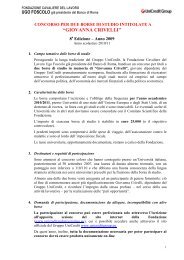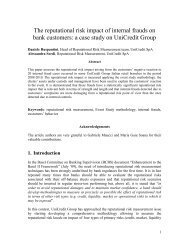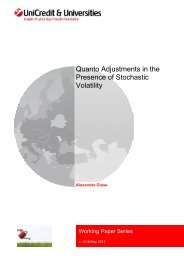Consistent Pricing of CMS and CMS Spread Options - UniCredit ...
Consistent Pricing of CMS and CMS Spread Options - UniCredit ...
Consistent Pricing of CMS and CMS Spread Options - UniCredit ...
You also want an ePaper? Increase the reach of your titles
YUMPU automatically turns print PDFs into web optimized ePapers that Google loves.
Figure 10: 10y2y spread digitals priced with a Power-t copula <strong>and</strong> skewed-t marginals.<br />
Figure 12.<br />
Finally, we present in Figure 13 contour plots <strong>of</strong> the joint distributions that are generated by<br />
the calibrated Power-Gaussian copula with normal marginals <strong>and</strong> the Power-t copula with skewedt<br />
marginals. Darker colours mean higher density values, for really low density values, we plotted<br />
black contour lines to better illustrate the tail behaviour.<br />
In case <strong>of</strong> the Power-Gaussian copula with normal marginals, we see that the probability mass<br />
is centered about the diagonal <strong>and</strong> around the convexity-adjusted <strong>CMS</strong> rates which is due to the<br />
symmetry <strong>of</strong> the normal marginals. Parameters θ1 <strong>and</strong> θ2 move a small amount <strong>of</strong> probability<br />
mass into the tails (“bulb” effect), <strong>and</strong> hence induce slightly heavier tails in a specific direction.<br />
Since θ1 <strong>and</strong> θ2 can be set independently from each other, they also generate a slight skew.<br />
In case <strong>of</strong> the Power-t copula with skewed-t marginals, the probability mass is neither centered<br />
about the diagonal nor around the convexity-adjusted <strong>CMS</strong> rates anymore which is due to the<br />
skewed-t marginals. With a positive/negative skew, the expected value <strong>of</strong> a skewed-t density is no<br />
longer centered at the peak, cf. figure 1. Therefore, the dark areas in Figure 13 are slightly <strong>of</strong>fset<br />
from the diagonal <strong>and</strong> the convexity-adjusted <strong>CMS</strong> rates. We further see that due to different skews<br />
in the marginals, different shapes <strong>of</strong> joint densities are generated. We also see that the tails are<br />
much heavier than in the normal case <strong>and</strong> become increasingly heavier with increasing maturity.<br />
This is in line with our calibration results, cf. Figure 11, where the degree-<strong>of</strong> freedom parameter<br />
decreases with increasing maturity indicating heavier tails for larger maturities. Parameters θ1<br />
<strong>and</strong> θ2 can no longer shift enough probability mass, thus high strike spread caplet prices are higher<br />
than in the normal case.<br />
7 Conclusion<br />
We followed a copula approach to <strong>CMS</strong> spread option pricing in order to replicate the current<br />
st<strong>and</strong>ard model, <strong>and</strong>, as the main result <strong>of</strong> this paper, to construct a manageable <strong>and</strong> well-behaved<br />
<strong>CMS</strong> rate joint distribution with fat tails <strong>and</strong> skew close to a bivariate SABR distribution <strong>and</strong><br />
consistent with both <strong>CMS</strong> <strong>and</strong> <strong>CMS</strong> spread option markets.<br />
To replicate the st<strong>and</strong>ard model, we used a Gaussian copula with normal marginals. We then<br />
extended this model in terms <strong>of</strong> a Power-Gaussian copula, cf. Andersen <strong>and</strong> Piterbarg [2010]. Finally,<br />
we introduced our new model, based on a Power-t copula <strong>and</strong> SABR-like skewed-t marginals,<br />
which both have not been used in the spread option literature before. The skewed-t distribution<br />
from Fern<strong>and</strong>ez <strong>and</strong> Steel [1996] is tractable <strong>and</strong> well-behaved, but can take into account skew<br />
<strong>and</strong> fat tails <strong>of</strong> the SABR distribution. Power-t copulas are a logical extension <strong>of</strong> Power-Gaussian<br />
19









